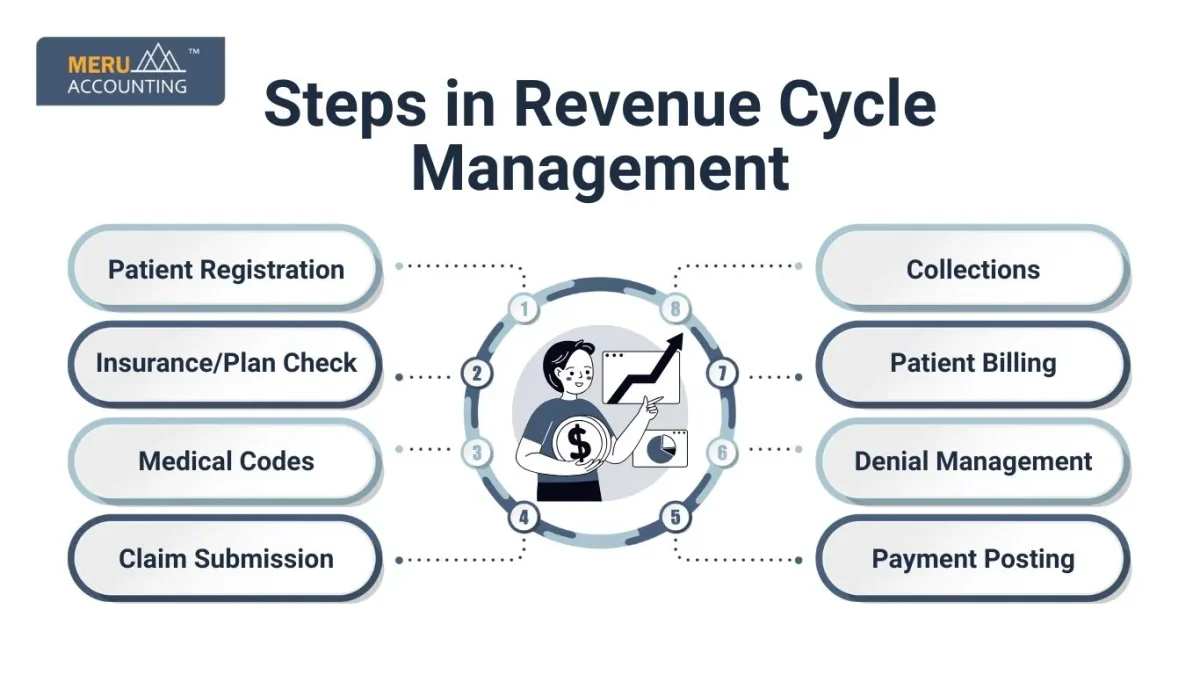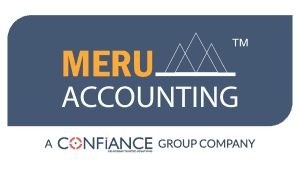How Revenue Cycle Management Improves Billing and Collections
Revenue cycle management helps clinics and hospitals earn money faster. It tracks every step from a patient visit to payment. Bills are made correctly and sent on time. Without this system, clinics face errors, late payments, and lost cash.
Effective revenue cycle management keeps staff work light and smooth. Patients get clear bills and pay faster. Clinics can track all payments and reduce mistakes. Overall, it makes work easier and keeps cash flow steady.
What is Revenue Cycle Management?
Definition
Revenue cycle management is the process of handling all payments. It starts when a patient signs in and ends with cash received.
Main Steps
- Collect patient info and plan details correctly.
- Make bills with correct codes and amounts.
- Send claims to plans without any delays.
- Follow up on unpaid bills each day.
- Keep clear records of all cash received.
This process links patient care, billing, and payments well. It keeps work smooth and avoids losing money.
Why Revenue Cycle Management Matters
Importance
Revenue cycle management helps clinics get money on time. It lowers errors and makes staff work easier.
Benefits
- Cuts claim denials and stops extra work.
- Speeds up plan and patient payments quickly.
- Patients trust clinics with clear, simple bills.
- Helps track cash and plan for the future.
- Makes staff work easier and less stressful.
Without this process, clinics face errors, late payments, and unhappy patients. It also wastes staff time and slows work.
Steps in Revenue Cycle Management
1. Patient Registration
- Record full patient details, phone, and address.
- Check plan info to avoid future errors.
- Keep all data ready for billing and care.
This first step ensures fewer errors in later work. It makes payment collection smoother and faster.
2. Insurance/Plan Check
- Confirm the plan covers the needed care.
- Check co-pays, limits, and plan rules carefully.
- Note gaps to avoid denied claims later.
This step helps prevent lost payments and claim delays. It keeps billing smooth and fast.
3. Medical Codes
- Put the correct codes for each visit or treatment.
- Double-check codes to avoid mistakes in claims.
- Keep codes up to date as rules change.
Correct codes help claims get paid on time. It lowers the risk of claim rejection.
4. Claim Submission
- Send claims to plans electronically without delay.
- Track claims to make sure the payment comes.
- Fix errors before sending to prevent rejections.
This step speeds up payment and reduces errors for clinics. It helps money come faster.

5. Payment Posting
- Enter plan and patient payments correctly.
- Match payments to the right bills carefully.
- Fix underpayments quickly to avoid lost cash.
This ensures clinics know what is paid and owed. It keeps cash records clear and accurate.
6. Denial Management
- Check rejected claims for errors immediately.
- Correct mistakes and resend claims quickly.
- Track patterns to stop repeated denials.
This saves time and ensures clinics keep money coming. It helps avoid revenue loss.
7. Patient Billing
Send Clear Bills
- Make bills easy to read and follow.
- Show plan adjustments and patient amounts clearly.
- Send bills soon to prevent late payment.
Clear bills build patient trust and reduce complaints. It makes payment collection much easier.
8. Collections
Collect Payments
- Follow up with patients on unpaid bills regularly.
- Offer simple payment plans for easier payment.
- Keep clear records of all payment attempts.
This step ensures clinics receive all cash on time. It lowers the risk of bad debt.
How Revenue Cycle Management Improves Billing
Accurate Billing
- Reduce errors in codes, patient info, and bills.
- Claims get approved faster with fewer problems.
- Staff spend less time fixing mistakes each day.
Faster Billing
- Bills are made fast manually or using tools.
- Patients and plans get bills without delay.
- Quick bills improve cash flow and clinic work.
Transparent Billing
- Bills show all charges, adjustments, and payments.
- Patients know exactly what to pay and when.
- Fewer complaints mean smoother daily operations.
Revenue cycle management makes billing clear, fast, and correct. It builds trust and improves cash collection.
How Revenue Cycle Management Helps Collections
Improve Cash Flow
- Plan and patient payments come faster with follow-ups.
- Pending payments are tracked to prevent lost cash.
- Clinics keep steady cash for work and expenses.
Reduce Bad Debt
- Follow up on unpaid bills regularly every week.
- Offer simple payment plans to make payments easier.
- Fewer write-offs mean clinics earn more money.
Better Patient Communication
- Send bills and reminders in simple, clear words.
- Explain charges and plan adjustments to patients.
- Patients pay faster and understand amounts clearly.
Revenue cycle management makes collections smooth and reliable. Clinics get more cash with less effort.
Technology in Revenue Cycle Management
Electronic Records
- Patient info and billing are stored in one system.
- Reduces errors from missing or wrong data entries.
- Speeds up work and keeps records clear.
Billing Software
- Bills are made automatically and sent on time.
- Tracks claims, payments, and overdue bills easily.
- Sends reminders to patients for faster payment.
Analytics Tools
- Shows trends in payment, errors, and denials.
- Helps clinics spot issues and fix them fast.
- Supports better decisions for cash and planning.
Technology makes revenue cycle management faster and simpler. Clinics see fewer errors and more timely payments.
Challenges in Billing and Collections
Claim Denials
- Errors in patient info or codes block payments.
- Plan coverage issues cause many claim denials.
- Verification prevents most errors before claims are sent.
Late Payments
- Patients may delay payment if bills are unclear.
- Plans may take extra time to approve claims.
- Revenue cycle management ensures fast follow-up and cash.
Manual Errors
- Data entry mistakes slow down claim approvals.
- Miscommunication between staff causes delays and confusion.
- Automation cuts errors and speeds up work daily.
Revenue cycle management solves the most common billing problems. Clinics keep cash coming with less staff stress.
Tips to Improve Revenue Cycle Management
Staff Training
- Train staff on codes, bills, and plan rules.
- Reduces errors and delays in payment collection.
- Keeps staff updated with the latest simple methods.
Regular Audits
- Audit bills and payments often for mistakes.
- Fix errors quickly to prevent lost revenue.
- Improves overall cash collection and clinic income.
Patient Communication
- Send clear bills and simple reminders always.
- Explain plan adjustments and patient amounts clearly.
- Helps patients pay on time and avoid issues.
Use Automation
- Automate repetitive tasks to save staff time.
- Improve billing and collection accuracy every day.
- Makes revenue cycle management simple and reliable.
These tips help revenue cycle management work better. Clinics get more cash with fewer mistakes.
Benefits of Revenue Cycle Management
Financial Stability
- Keeps cash flowing smoothly with no gaps.
- Reduces stress and ensures money is ready for work.
Fewer Denials
- Claims get approved faster with fewer mistakes.
- Staff spend less time fixing rejected claims.
Better Patient Experience
- Clear bills make patients happy and satisfied.
- Patients trust clinics and return for care.
Efficiency
- Billing, coding, and payment work happen fast.
- Staff spend less time fixing mistakes each day.
Compliance
- Follows the plan and government rules correctly.
- Avoids fines and keeps clinics safe legally.
Key Metrics in Revenue Cycle Management
- Track the number of claims sent and paid daily.
- Measure the average time to receive payment from plans.
- Check the rate of claim denials and rejections often.
- Monitor patient payment trends and overdue balances clearly.
Tracking these numbers helps clinics spot problems fast. It also guides staff on where to focus improvement efforts.
Role of Staff in Revenue Cycle Management
- Front desk staff collect patient info and plan details.
- Coders ensure all treatments have the correct codes for billing.
- Billing staff create accurate bills and submit claims fast.
- The collections team follows up on unpaid bills effectively.
Every staff member plays a key role in RCM. Teamwork ensures smooth payment flow and fewer errors.
Revenue cycle management strengthens cash flow and daily work. Clinics earn more and operate smoothly.
Revenue cycle management is key to clinic success. It improves billing, speeds up payments, and reduces errors. Clinics get faster cash and build patient trust. Staff work is simpler, organized, and stress-free.
Meru Accounting Services helps clinics get paid on time. We make sure all bills are correct and clear. Claims are tracked closely to avoid delays or errors. Staff and tools make collections fast with our services. Clinics using Meru Accounting services see more cash flow. Our revenue cycle services boost both funds and care.
FAQs
- What is revenue cycle management?
It is the process to track and handle all payments. - Why is RCM important?
It ensures clinics get paid fast and avoid errors. - How does RCM improve billing?
It makes bills correct, clear, and sent on time. - Can RCM reduce claim denials?
Yes, by checking patient info and plan coverage carefully. - Does technology help in RCM?
Yes, software and records reduce mistakes and save time. - How does RCM improve collections?
It tracks unpaid bills and follows up regularly. - Who should use revenue cycle management?
Clinics, hospitals, and providers want smooth billing and cash flow.








